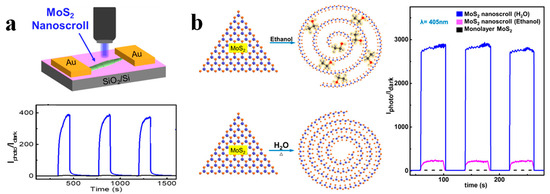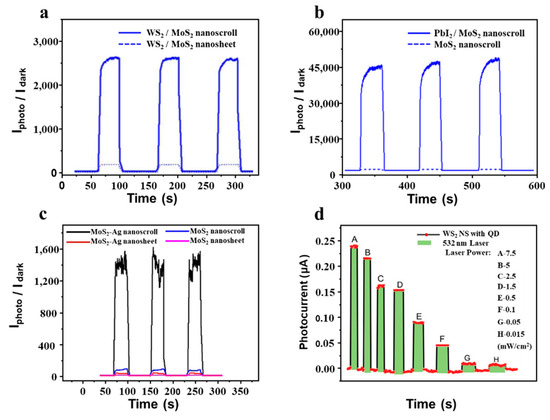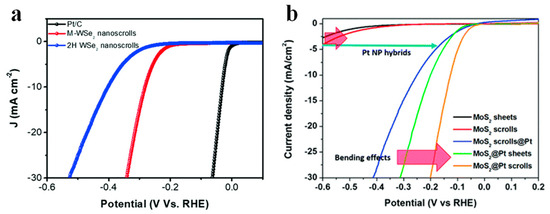Your browser does not fully support modern features. Please upgrade for a smoother experience.
Please note this is an old version of this entry, which may differ significantly from the current revision.
Subjects:
Nanoscience & Nanotechnology
Two-dimensional (2D) transition metal dichalcogenides (TMDCs) nanosheets have shown extensive applications due to their excellent physical and chemical properties. However, the low light absorption efficiency limits their application in optoelectronics. By rolling up 2D TMDCs nanosheets, the one-dimensional (1D) TMDCs nanoscrolls are formed with spiral tubular structure, tunable interlayer spacing, and opening ends. Due to the increased thickness of the scroll structure, the light absorption is enhanced. Meanwhile, the rapid electron transportation is confined along the 1D structure.
- TMDCs
- nanosheet
- nanoscroll
- preparation
1. Introduction
As representative two-dimensional (2D) materials, the transition metal dichalcogenides (TMDCs) nanosheets have been successfully applied in the fields of photodetection [1,2,3,4,5,6], energy storage [7,8,9,10,11], catalysis [12,13,14,15,16], and so on. Although the monolayer TMDCs nanosheets have shown excellent optoelectronic performance, their low light absorption efficiency hinders the applications in photodetection [17], because of their ultrathin thickness.
A great deal of effort has been developed to improve the light absorption of TMDCs nanosheets, such as plasma treatment, formation of van der Waals heterojunction, utilization of plasmonic effect, integration of quantum dots [18,19,20,21,22], etc. Recently, rolling up the monolayer TMDCs nanosheet to form the TMDCs nanoscroll (TMDCs-NS) has been reported as a promising method to improve their optoelectronic performance [19]. With the aid of volatile organic solvents or alkaline solution [19,23,24,25,26,27], the monolayer TMDCs nanosheets can be transformed into one-dimensional (1D) nanoscrolls with tubular and spiral structures [23,28,29]. The as-obtained TMDCs nanoscroll (TMDCs-NS) showed enhanced light absorption due to the increased cross-section. In addition, the TMDCs-NS also inherits the excellent properties from the monolayer TMDCs nanosheet [21,30,31,32,33,34,35]. Furthermore, the curved structure of the nanoscroll exhibits strain, which can modulate the band gap of TMDCs nanosheet [33]. Moreover, its scrolled structure has tunable interlayer space with open ends, in which other functional nanomaterials can be encapsulated [35,36]. Therefore, the TMDCs-NS have attracted great attention in optoelectronics in recent years.
2. Photodetector Based on TMDCs-NS
Compared to monolayer TMDCs nanosheet, the TMDCs-NS shows much better light absorption efficiency due to its increased thickness of spirally scrolled structure. Thus, the TMDCs-NS should exhibit excellent optoelectronic performance. Recently, the photodetection performance of TMDCs-NS has been investigated [51,98]. Photosensitivity, described by the ratio of photocurrent to dark current (PDR), is one of the most important parameters to evaluate the performance of a photodetector [19,23,35]. Figure 1a shows the PDRs of MoS2 nanosheet and nanoscroll-based photodetectors under blue light irradiation with a bias voltage of 0.1 V. The PDR of a nanoscroll-based photodetector is about 400, which is about 100 times higher than that of a nanosheet-based one [23]. In addition, the response and recovery time of a nanoscroll-based photodetector is less than the nanosheet-based photodetector. Similar enhanced PDR was also observed in the MoSe2 nanoscroll-based device [17]. These results indicate that the TMDCs-NS shows much better photodetection performance than the TMDCs nanosheet, which should be attributed to the enhanced light absorption and rapid electron transportation along the 1D structure [24,52]. The photodetection enhancement of TMDCs nanoscrolls could be explained in detail as follows. Firstly, the increased thickness of TMDCs nanoscroll increases the light absorption as the light permeates each layer of the nanoscroll. Although each layer shows low light absorption, the total light absorption of the nanoscroll has increased. Therefore, increased photocurrent is obtained in nanoscroll. In addition, the one-dimensional structure of the nanoscroll confines the electron transportation along the axis direction, and thus rapid electron movement is realized in the nanoscroll compared to that in a 2D nanosheet. Moreover, due to the large surface-to-volume ratio of the MoS2 nanosheet, the adsorbates, such as O2 and H2O molecules, greatly reduce the photoresponse of the MoS2 nanosheet-based device. The MoS2 nanoscroll has a much smaller surface-to-volume ratio than the nanosheet, which can decrease the influence of adsorbates on the photoresponse.

Figure 1. Photodetection performance of TMDCs-NS based device. (a) Top panel: Scheme of photodetector based on MoS2 nanoscroll. Bottom panel: PDR plot of photodetectors based on MoS2 nanosheet and nanoscroll under 405 nm laser [23]. (b) The scheme of nanoscrolls is made by dropping ethanol and water droplets, respectively. PDR plot of corresponding photodetectors under 405 nm laser [52].
Compared to the MoS2 nanoscroll prepared by ethanol droplet (MoS2 NS-ethanol), the MoS2 nanoscroll prepared by water droplet (MoS2 NS-water) shows higher PDR (Figure 1b) [52]. The ethanol molecules trapped in MoS2 NS-ethanol reduce the light absorption and hinder the interlayer transport of photogenerated carriers, and thus decrease the photoresponse. In addition, the ethanol can donate an electron to MoS2 and thus increase the dark current of MoS2 NS-ethanol, which in turn decreases the PDR. Moreover, the MoS2 NS-water shows a slightly higher photocurrent than MoS2 NS-ethanol.
3. Photodetector Based on TMDCs-NS Composite
In bilayer WS2/MoS2 heterostructure, the carriers can be transferred from MoS2 to WS2 within 50 fs under illumination, indicating the important role of interface. However, there is only one interface in the bilayer WS2/MoS2 heterostructure. The photoresponse performance of WS2/MoS2 heterostructure could be further improved if multiple interfaces can be established. By scrolling the bilayer WS2/MoS2 heterostructure into WS2/MoS2 heterostructure nanoscroll, multiple hetero-interfaces are formed, which could show better photoresponse than the bilayer WS2/MoS2 heterostructure with one hetero-interface. After the bilayer WS2/MoS2 heterostructure was grown by CVD, the alkaline droplet was dropped on it to roll up the bilayer heterostructure into a nanoscroll [19]. As shown in Figure 2a, the PDR of bilayer WS2/MoS2 heterostructure-based photodetector is ~180 under a blue laser, which is much higher than that of monolayer MoS2 or WS2 nanosheets. The PDR of WS2/MoS2 heterostructure nanoscroll-based photodetector is 2700, about an order of magnitude higher than that of bilayer WS2/MoS2 heterostructure-based photodetector.

Figure 2. Photodetector based on TMDCs-NS composite. (a) Plots of the PDRs of photodetectors based on WS2/MoS2 nanosheet and nanoscroll under blue laser [19]. (b) PDRs plots of photodetectors based on MoS2 nanoscrolls and PbI2/MoS2 nanoscrolls under 405 nm lasers [51]. (c) Plots of the PDRs of the MoS2 nanosheet, MoS2 nanoscroll, MoS2-Ag nanosheet, and MoS2-Ag NS under a 633 nm laser [35]. (d) Photocurrent variations in hybridized WS2 nanoscroll photodetectors under different power densities of a 532 nm laser [79].
By encapsulating photoactive PbI2 nanocrystals into MoS2 nanoscroll, the PDR of MoS2 nanoscroll can be enhanced by two orders of magnitude (Figure 2b) [51]. Similarly, the PDRs of MoS2 and WS2 nanoscrolls also increased by two orders of magnitude after Ag nanoparticles were trapped in a nanoscroll (Figure 2c) [35]. Moreover, the photoresponsivity of the MoS2 nanoscroll was also enhanced by about two orders of magnitude when BaTiO3 nanoparticles were encapsulated into it [27]. By doping the WS2 nanoscroll with CdSe–ZnS quantum dots, the photosensitivity can be enhanced 3000-fold (Figure 2d) [79]. Compared to single TMDCs nanoscrolls, the nanoscroll composite shows excellent photodetection performance [24,70], indicating it could be a promising candidate for high-performance optoelectronics.
4. Hydrogen Evolution Reaction
The conductivity and effective active site of the catalyst are two key factors in improving the hydrogen precipitation reaction (HER) [99,100,101]. TMDCs are considered promising candidates after noble metals for catalytic hydrogen precipitation due to their good electrical conductivity and abundant active edges [66,102,103]. The introduction of a small amount of MoSx greatly enhanced the HER activity of NbS2 nanoflakes [100]. The theoretical calculation indicates that Mo edge sites are identified as the catalytically active site for HER [104,105].
A number of efforts have been employed to increase the active sites and conductivity of TMDCs materials [106,107,108]. Among them, transforming the TMDCs nanosheets into nanoscrolls with active edges is of great interest in electrocatalytic HER [50]. By curling the TMDCs nanosheets to form nanoscrolls, the curled edges provide highly active edge sites for efficient catalysis. Meanwhile, the bending strain of the basal plane also provides more active sites due to the scrolled structure [50,109,110,111]. In addition, the specific surface area of the nanoscroll increases, converting the solution contact from single-sided contact of the nanosheet to multi-layer contact [112]. As a result, the TMDCs-NS provides higher catalytic activity and better conductivity. Thus, the HER activity of TMDCs-NS is greatly enhanced. Figure 3a shows the polarization curves of metallic WSe2 (M-WSe2) and 2H-WSe2 nanoscrolls compared to the commercial Pt/C catalyst. The M-WSe2 nanoscroll exhibits higher HER activity, smaller overpotential, and larger current densities than the 2H-WSe2 nanoscroll, attributed to its good conductivity and enhanced catalytic activity from the scrolled structure [103]. Figure 3b shows the linear scanning voltammogram curves of current density and potential for Pt electrode, MoS2 sheet, MoS2 nanoscroll, MoS2 nanoscrolls@Pt, MoS2@Pt sheet, and MoS2@Pt nanoscroll [48]. The MoS2 nanosheet shows overpotential over 400 mV, while that of the MoS2 nanoscroll decreases. The overpotential of MoS2 nanoscroll decorated by Pt nanoparticles (NPs) greatly decreases, indicating the important role of Pt NPs in enhancing the HER activity. By decorating Pt NPs on MoS2 nanosheet (MoS2@Pt sheet), the overpotential further decreases to around 300 mV. After the MoS2@Pt sheet was rolled up to form a MoS2@Pt scroll, the overpotential was reduced to 200 mV, implying the basal plane bending of the nanoscroll can further improve the HER activity.

Figure 3. Hydrogen evolution reaction (HER) based on TMDCs-NS. (a) HER polarization curves for M-WSe2 nanoscrolls, 2H-WSe2 nanoscrolls, and the commercial Pt/C [103]. (b) Polarization curves for Pt electrode, MoS2 sheet, MoS2 nanoscroll, MoS2 nanoscrolls@Pt, MoS2@Pt sheet, and MoS2@Pt nanoscroll [48].
5. Gas Sensor
In recent years, TMDCs nanosheets have attracted great attention for gas sensing because of their large surface-to-volume ratio and good electrical properties [113,114,115,116]. The TMDCs nanosheet-based gas sensors show high sensitivity for trace gas molecules and good selectivity at room temperature [60,117,118,119]. However, they suffer from incomplete recovery and poor stability [120], which limit their practical applications. The TMDCs-NS has good conductivity due to its 1D structure and specific surface area from the tubular structure. Meanwhile, the nanoscroll structure also provides tunable space to encapsulate functional nanomaterials for further enhanced performance. Therefore, the TMDCs-NS has been considered to present promising performance in the field of gas sensing [121].
By electrochemically exfoliating InSe crystal in electrolytes containing cetyltrimethylammonium bromide (CTAB), the CTAB-functionalized InSe nanosheets (C-InSe) were obtained [120]. With the aid of solvent evaporation, the C-InSe nanosheets rolled up to form C-InSe nanoscroll. After the as-obtained C-InSe nanoscrolls were deposited on interdigitated electrodes (Figure 4b), they were placed into a chamber with a fixed concentration of NO2 gas. An LED lamp illuminates light into the chamber through a glass cover (Figure 4a). The response of the C-InSe nanoscrolls-based sensor increases under light illumination (Figure 4c). The enhanced response has arisen from the increased adsorption of NO2 molecules favored by photogenerated electrons. While desorption of NO2 is observed as the light intensity increases further, which decreases the response of the sensor. As the concentration of NO2 increases from 100 ppb to 25 ppm, the response of C-InSe nanosheets and nanoscrolls-based sensors largely increases (Figure 4d). However, the C-InSe nanoscrolls-based sensor exhibits a much better response than the C-InSe nanosheets-based sensor, indicating the superiority of nanoscrolls in gas sensing.

Figure 4. Gas sensor based on C-InSe nanoscrolls [120]. (a,b) Schematic illustration of C-InSe nanoscroll-based gas sensor and test platform. (c) Response curves of C-InSe nanoscrolls sensor towards 1 ppm NO2 under blue light irradiation with different light intensities. (d) Relationship between the response of C-InSe nanosheets and nanoscrolls based sensors and NO2 concentration.
This entry is adapted from the peer-reviewed paper 10.3390/nano13172433
This entry is offline, you can click here to edit this entry!
